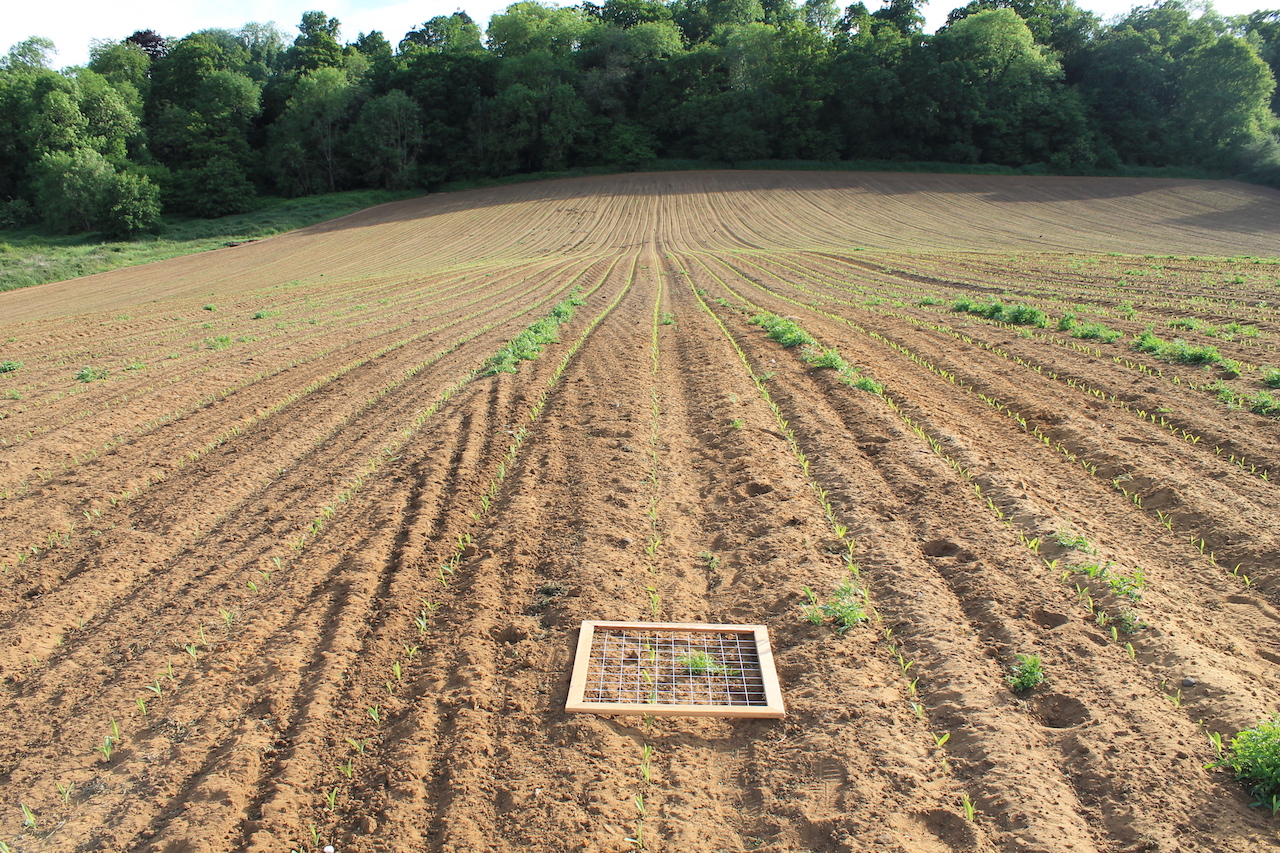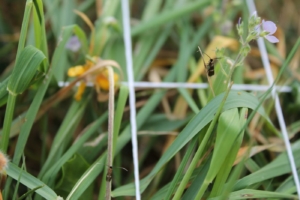NOTES FROM THE FIELD is an amateur entomological and botanical study in four locations, at five different times of day. The Monoculture Field, Front Garden, Roadside Verge and Meadow – although ecologies within 150m of each other, they each support widely different multispecies entanglements.
Growing up in this area and walking almost daily across the fields, I have seen the spaces in recent years not only under threat from housing developments – but in 2018 the Monoculture Field was sprayed repeatedly with herbicide, including hedgerow. Maize now grows as close to its boundaries as possible.
With histories of human use and abandonment, the adjacent Meadow has rewilded itself. Entanglements of scrub, grasses and trees provide a site of resistance: homes for insects and wild life. Yet this area is again under threat.
NOTES FROM THE FIELD came about through a need to emphasise the Meadow’s biodiversity, its interconnectedness and ecological value to the community of non- humans and humans alike. Threats to wilder patches continue despite awareness of global ecological breakdown and sixth mass-extinction – including the recent alarming data of plummeting numbers of insects and pollinators. Habitat loss and pesticide pollution are major factors to this downward spiral. 97% of the UK’s wildflower meadows have been lost since 1950.
This work is a blueprint for further projects to engage with local communities and specific sites: entomological and botanical surveys focussed within the space of the ‘Quadrat’ grid, to gain better understanding of the wildness that surrounds us.
This is an act of drawing as ecological activism.



Monoculture
Maize, (1,2) (2,7) (6,6) (10,3)
Shepherd’s Purse, (6,7)
Horsetail, (4,7)
Dwarf Thistle, (3,10)
Clover, (3,10)
St. John’s Wort, (3,3)
Grass shoot, (9,2) (10,10)
P. Illicus, (10,6)
Ground Beetle, (8,5)
Clover, (1,4)
Garden
Dandelion, (8,6) (5,2) (1,3)
Orb weaver (unknown), (7,0)
White Tail Bumblebee, (10,10) (2,8)
Iris (2,8)
Black Ant, (0.2) (10,3)
Long body fly (unknown), (8,10)
Apple tree, (9,4)
Clover, (3,3) (4,4) (8,3) (4,1)
C. Coerulous, (9,4)
Red Tailed Bumblebee, (7,7)
Spider (unknown), (10,4) (2,6)
Green fly (unknown), (0,8) (0,7) (4,9)
Midges (unknown), (4,6)
Harvestman, (2,4)
H. Non-Scripta, (7,7)
Woodlouse (unknown), (7,3)
Common Daisy, (8,3)
Black fly (unknown), (10,7)
Common Carder Bumblebee, (7,9)
Horsetail, (4,6)
Red Ant, (8,2)
Herb Robert, (8,8)
Hedge Cranesbill, (3,8)
Common Speedwell, (4,3) (2,9)
Roadside
Soldier Beetle, (10,9) (9,10)
Cow Parsley, (10,9) (8,5)
Black Fly (unknown), (0,3) (8,0)
Green fly (unknown), (10,7)
Cleavers, (2,8) (6,6)
Ivy (unknown), (8,1)
Cut grass, (scattered)
Red Tailed Bumblebee, (8,1)
Common Daisy, (8,4)
Ribgrass, (5,9) (1,1)
Blue Bottle, (10,5)
Clover, (1,7)
C. Melanocephalus, (4,5)
P. Cupreus, (8,4)
Nettle, (2,10)
White Lipped Snail, (5,8)
Brown Spider (unknown), (0,6)
Small White Wave, (7,10)
Orb weaver (unknown) (3,10)
Hover fly larvae, (9,9)
Dunbar Moth, (8,4)
Garden Ant, (5,2) (6,2)
Hover fly (unknown), (1,10)
Buttercup, (4,3)
Midges (unknown), (3,10)
Herb Robert, (7,8)
Dandelion, (7,10)
Meadow
Four Spotted Moth, (0,7)
Common Speedwell, (1,7 (4,5) (10,4) (9,1)
Spider (unknown), (0,5)
Horsetail, (3,4) (1,5) (10,1)
Lesser House Fly, (3,10)
Rosel’s Bush Cricket, (4,0)
P. Pomaceus, (4,4) (9,9) (2,9) (10,2)
Meadow Plant Bug, (4,10) (10,7) (8,3) (0,7) (7,7)
Current Clearwing, (4,3)
Bush Cricket, (1,1)
Garden Snail, (3.6)
Hoverfly (unknown), (5,2)
P. Picta, (9,3)
M. Notula, (7,2)
7-Spot Ladybird, (6,7) (1,5) (7,5) (2,9)
Meadow Grasshopper, (7,-1)
Midges (unknown), (flying over)
Nettle, (9,9) (2,9) (4,2)
White Dead Nettle (3,6)
White Tail Bumblebee (0,9) (4,9) (10,10) (10,8) (10,7) (10,1) (4,5) (3,7) (6,9)
Buttercup, (10,10) (3,3) (7,6) (5,9) (6,8)
14 Spot Ladybird, (6,4)
Red Ant (10,0) (10,7) (5,8)
Orange Aphid (unknown), (10,3)
T. Livido (4,0)
Crab Spider (unknown), (2,2)
Black fly (unknown), (6,0)
Common Vetch, (7,9) (8,4)
Small White Wave Moth, (10,4)
Ribgrass, (2,5) (10,8)
Sheep Sorrel, (7,0)
Green fly (unknown), (10,2) (2,7)
Yellow-barred Long Horn Moth (5,3) (6,5)
Meadow long grass, (all over)
Cleavers, (8,7) (1,3)
Bramble, (8,4) (8,10) (3,8)
Caterpillar (6-Spot Burnet Moth), (8,5)
O. Nobilis, (5,5) (6,8)
Soldier Beetle, (0,4)
Black Ant, (2,2) (3,2) (6,2) (8,4)
Moth (unknown), (8,10)
Star Thistle (5,4)
Mayfly (unknown), (0,8)
Black aphid on nettle (unknown), (4,2)
This is part of ROOT MAPPING, a section of The Learned Pig devoted to exploring which maps might help us live with a clear sense of where we are. ROOT MAPPING is conceived and edited by Melanie Viets.











